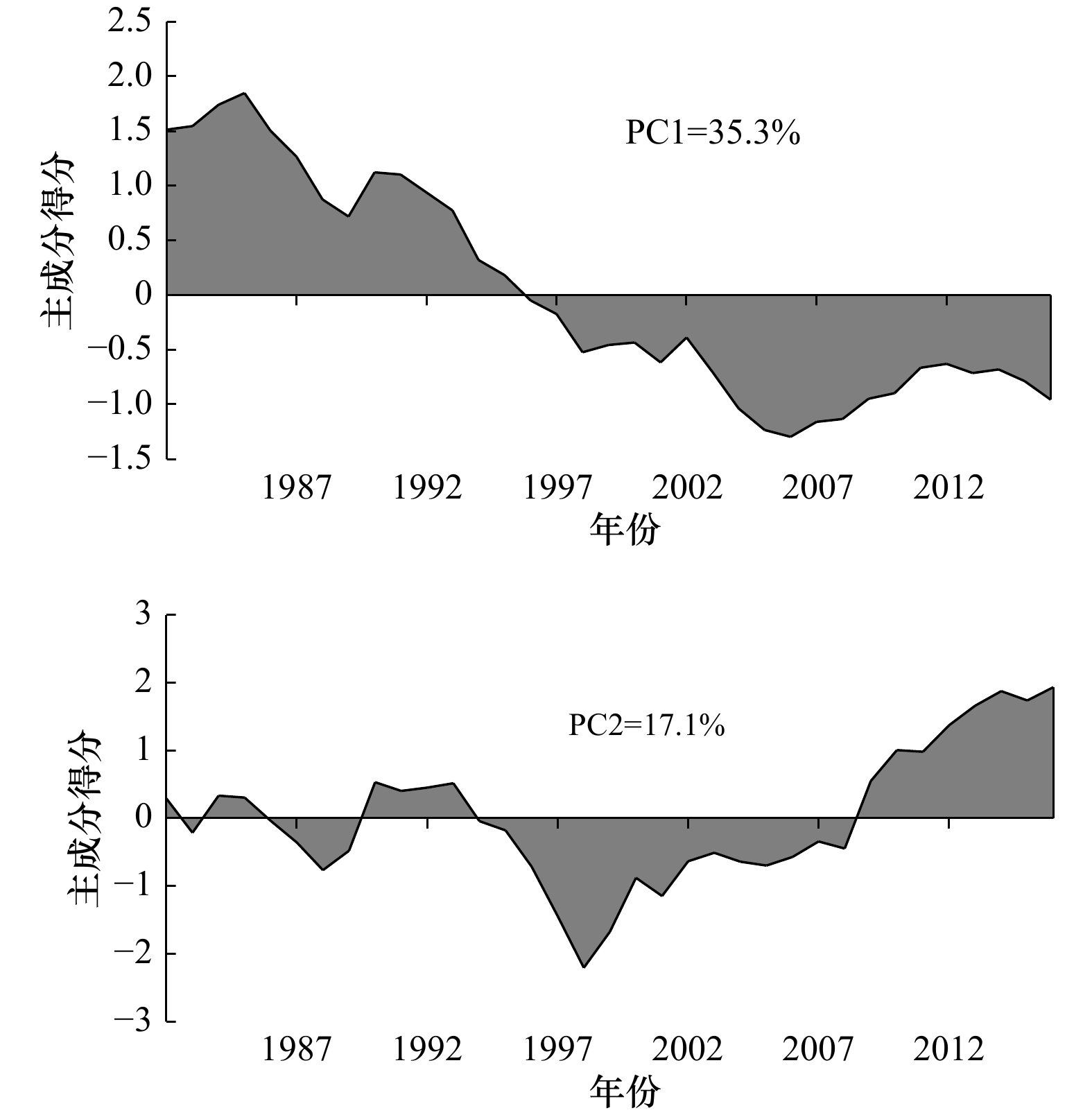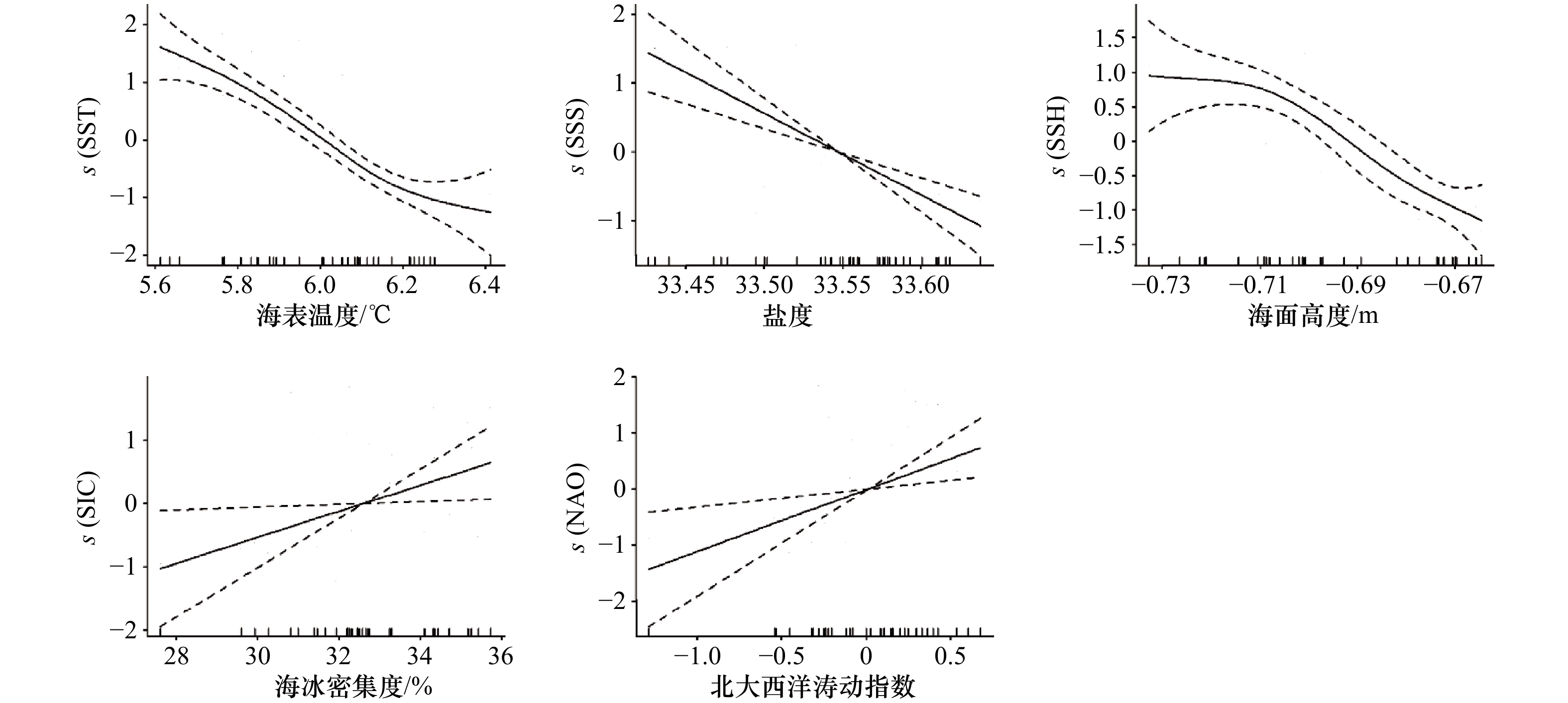Effects of climate change on catch composition, diversity of catch and mean trophic level in the Northeast Atlantic Ocean
-
摘要: 东北大西洋是世界上重要的捕捞海域,气候变化对该海域捕捞产生了重要的影响。本文基于联合国粮农组织所提供的1982−2016年东北大西洋渔获产量数据,对该海域渔获物组成、多样性、平均营养级及主成分变化特征进行时间序列上的分析,并结合东北大西洋海域气候、环境因子,应用广义可加模型探究渔获物组成与气候变化之间的关系。结果显示:渔获物多样性的变化总体上呈下降趋势,2002−2010年间处于较低水平;平均营养级在2002年之前呈平缓下降的趋势,2002年之后开始波动上升,相关性分析表明这两个指标与海域环境因子的变化较为相关。对渔获物组成进行主成分分析显示,第一主成份变化的方差解释率达到35.3%,且与海域气候、环境因素有较高的相关性,第一主成分变化能够较好地表征气候影响下渔获物组成变化的情况。广义可加模型分析结果显示,渔获物组成变化的影响因素按解释率由高到低分别为:海表温度、海平面高度、盐度、海冰和北大西洋涛动指数。该研究有助于认识气候变化对海洋渔业资源及其结构组成的影响。Abstract: Global climate change has a profound impact on the world fisheries. Recently, the composition of catch in Northeast Atlantic Ocean has changed significantly. Based on the catch data in the Northeast Atlantic Ocean from 1982 to 2016 provided by the United Nations Food and Agricuture Organization, the diversity of catch, mean trophic level and the variation of principal component were analyzed in time series. Finally, combined with climate and environmental factors (sea surface temperature, SST; sea surface salinity, SSS; sea surface height, SSH; Sea Ice Concentration, SIC; North Atlantic Oscillation, NAO; Arctic Oscillation, AO; Atlantic Multidecadal Oscillation, AMO) in the Northeast Atlantic Ocean, the relationship between catches composition and climate change was explored by generalized additive model (GAM). The results showed that the diversity generally presented a declining trend, it was at a relatively low level during 2002 to 2010. The mean trophic level decreased slowly before 2002, then began to rise sharply. The correlation analysis showed that the changes of these two indicators were related to the environmental factors. The principal component analysis of catch composition showed that the variance of the first principal component was 35.3%, and it also has a close relationship with climatic and environmental factors, which could characterize the change of catch structure under the influence of climate. The results of GAM analysis showed that the orders of the contribution to structure change of catches were in sequence of SST, SSH, SSS, SIC and NAO.
-
Key words:
- Northeast Atlantic Ocean /
- climate change /
- catch composition /
- diversity of catch /
- mean trophic level
-
表 1 渔获物组成第1和第2主成分载荷值
Tab. 1 Loadings on the first and second principal components from the analysis of catch composition
种类 拉丁学名 主成分载荷值 PC1 PC2 大西洋鲱 Clupea harengus −0.733 −0.223 大西洋鳕 Gadus morhua 0.236 0.811 毛鳞鱼 Mallotus villosus 0.671 −0.123 蓝鳕 Micromesistius poutassou −0.537 −0.422 大西洋鲭 Scomber scombrus −0.508 0.757 玉筋鱼属 Ammodytes spp 0.713 −0.192 绿青鳕 Pollachius virens 0.085 0.121 黍鲱 Sprattus sprattus −0.816 −0.370 黑线鳕 Melanogrammus aeglefinus −0.366 0.484 挪威长臀鳕 Trisopterus esmarkii 0.903 0.144 竹䇲鱼 Trachurus trachurus 0.315 −0.110 平鲉属 Sebastes spp 0.932 −0.034 沙丁鱼 Sardina pilchardus 0.812 −0.138 欧洲鲽 Pleuronectes platessa 0.764 0.521 牙鳕 Merlangius merlangus 0.913 0.181 欧洲无须鳕 Merluccius merluccius −0.173 0.943 竹䇲鱼属 Trachurus spp 0.173 −0.164 魣鳕 Molva molva 0.634 0.583 格陵兰大比目鱼 Reinhardtius hippoglossoides 0.316 0.624 欧洲鳀 Engraulis encrasicolus −0.225 0.242 长鳍金枪鱼 Thunnus alalunga 0.607 0.188 单鳍鳕 Brosme brosme 0.759 0.333 鳎 Solea solea 0.425 0.020 鳐科 Rajidae 0.703 −0.593 北极鳕 Boreogadus saida 0.086 −0.433 白斑角鲨 Squalus acanthias 0.976 0.066 鮟鱇属 Lophius spp 0.084 0.627 尖吻平鲉 Sebastes mentella −0.842 −0.066 金平鲉 Sebastes marinus −0.881 0.099 鮟鱇 Lophius piscatorius −0.698 0.063 大西洋狼鱼 Anarhichas lupus 0.054 −0.133 水珍鱼属 Argentina spp −0.749 0.102 圆鲭 Scomber colias −0.657 0.666 条长臀鳕 Trisopterus luscus 0.690 0.093 表 2 气候、环境因素第1和第2主成分载荷值
Tab. 2 Loadings on the first and second principal components from the analysis of the climatic and environmental factors
因素 主成分载荷值 PC Ⅰ PC Ⅱ 温度 0.935 0.284 盐度 0.610 0.632 海面高度 0.820 −0.086 海冰 −0.660 −0.437 北大西洋涛动指数 −0.580 0.744 大西洋年代际涛动指数 0.863 −0.183 北极涛动指数 −0.335 0.833 表 3 气候、环境因素主成分变化与各类渔获物组成指数相关性系数
Tab. 3 The correlation coefficients of climatic and environmental factors principal component scores and different kinds of catch composition indexes
多样性指数 平均营养级 PC1 PC2 PCI −0.609** 0.623** −0.783** 0.396 PCII 0.370 −0.225 0.382* 0.148 注:*表示p<0.05下相关性显著,**表示p<0.01下相关性极显著。 表 4 渔获物组成PC1与各气候、环境因素的GAM模型拟合
Tab. 4 GAM models fitted to the first principal component scores of catch composition (PC1) and climatic and environmental factors
模型因子 P值 F值 累计解释偏差/% 可解释偏差/% AIC值 +水温 2.12×10−2 6.05 74.8 74.8 59.53 +盐度 1.46×10−4 9.27 81.2 6.4 59.48 +海面高度 7.10×10−5 22.08 89.2 8.0 42.65 +海冰 1.73×10−4 19.15 92.3 3.1 24.20 +北大西洋涛动 3.82×10−1 1.14 94.3 2.0 16.84 +大西洋年代际涛动 6.83×10−1 0.17 94.4 0.1 18.82 +北极涛动 4.44×10−1 0.60 94.6 0.2 19.31 -
[1] Brander K M. Global fish production and climate change[J]. Proceedings of the National Academy of Sciences of the United States of America, 2007, 104(50): 19709−19714. [2] Pörtner H O, Knust R. Climate change affects marine fishes through the oxygen limitation of thermal tolerance[J]. Science, 2007, 315(5808): 95−97. [3] Cheung W W L, Lam V W Y, Sarmiento J L, et al. Large-scale redistribution of maximum fisheries catch potential in the global ocean under climate change[J]. Global Change Biology, 2010, 16(1): 24−35. [4] Beaugrand G. Marine Biodiversity, Climatic Variability and Global Change[M]. New York: Routledge, 2014: 486. [5] Pauly D, Watson R. Background and interpretation of the ‘Marine Trophic Index’ as a measure of biodiversity[J]. Philosophical Transactions of the Royal Society B: Biological Sciences, 2005, 360(1454): 415−423. [6] 余为, 陈新军, 易倩. 不同气候模态下西北太平洋柔鱼渔场环境特征分析[J]. 水产学报, 2017, 41(4): 525−534.Yu Wei, Chen Xinjun, Yi Qian. Analysis of variations in the environmental conditions on the fishing ground of neon flying squid (Ommastrephes bartramii) in the Northwestern Pacific Ocean under different climate modes[J]. Journal of Fisheries of China, 2017, 41(4): 525−534. [7] 汪金涛, 陈新军. 中西太平洋鲣鱼渔场的重心变化及其预测模型建立[J]. 中国海洋大学学报, 2013, 43(8): 44−48.Wang Jingtao, Chen Xinjun. Changes and prediction of the fishing ground gravity of skipjack (Katsuwonus pelamis) in western-central Pacific[J]. Periodical of Ocean University of China, 2013, 43(8): 44−48. [8] IPCC, 2014. Climate Change 2014: Impact, Adaptation, and Vulnerability[R]. Cambridge: Cambridge University Press, 2014. [9] Sirabella P, Giuliani A, Colosimo A, et al. Breaking down the climate effects on cod recruitment by principal component analysis and canonical correlation[J]. Marine Ecology Progress Series, 2001, 216: 213−222. [10] Drinkwater K F. The response of Atlantic cod (Gadus morhua) to future climate change[J]. ICES Journal of Marine Science, 2005, 62(7): 1327−1337. [11] Perry A L, Low P J, Ellis J R, et al. Climate change and distribution shifts in marine fishes[J]. Science, 2005, 308(5730): 1912−1915. [12] Rose G A. Capelin (Mallotus villosus) distribution and climate: a sea “canary” for marine ecosystem change[J]. ICES Journal of Marine Science, 2005, 62(7): 1524−1530. [13] Fossheim M, Johannesen E, Primicerio R, et al. Spatial variation and structural change of the Barents Sea fish community[R]. Torsharn, Faroe Island: International Council for the Exploration of the Sea, 2009, E: 21. [14] Stenevik E K, Sundby S. Impacts of climate change on commercial fish stocks in Norwegian waters[J]. Marine Policy, 2007, 31(1): 19−31. [15] Simpson E H. Measurement of diversity[J]. Nature, 1949, 163(4148): 688. [16] Pauly D, Christensen V, Guénette S, et al. Towards sustainability in world fisheries[J]. Nature, 2002, 418(6898): 689−695. [17] Pauly D, Palomares M L, Froese R, et al. Fishing down Canadian aquatic food webs[J]. Canadian Journal of Fisheries and Aquatic Sciences, 2001, 58(1): 51−62. [18] Tian Y J, Kidokoro H, Watanabe T. Long-term changes in the fish community structure from the Tsushima warm current region of the Japan/East Sea with an emphasis on the impacts of fishing and climate regime shift over the last four decades[J]. Progress in Oceanography, 2006, 68(2/4): 217−237. [19] Caddy J F, Garibaldi L. Apparent changes in the trophic composition of world marine harvests: the perspective from the FAO capture database[J]. Ocean & Coastal Management, 2000, 43(8/9): 615−655. [20] Pauly D, Christensen V V, Dalsgaard J, et al. Fishing down marine food webs[J]. Science, 1998, 279(5352): 860−863. [21] United Nations Food and Agricuture Organization. The State of World Fisheries and Aquaculture[R]. Rome: FAO, 2000. [22] Simmonds E J. Comparison of two periods of North Sea herring stock management: success, failure, and monetary value[J]. ICES Journal of Marine Science, 2007, 64(4): 686−692. [23] Horwood J, O'Brien C, Darby C. North Sea cod recovery?[J]. ICES Journal of Marine Science, 2006, 63(6): 961−968. [24] 焦敏, 高郭平, 陈新军. 东北大西洋海洋捕捞渔获物营养级变化研究[J]. 海洋学报, 2016, 38(2): 48−63.Jiao Min, Gao Guoping, Chen Xinjun. Changes in trophic level of marine catches in the northeast Atlantic[J]. Haiyang Xuebao, 2016, 38(2): 48−63. [25] 林楠, 苗振清, 卢占晖. 东海中部夏季鱼类群落结构及其多样性分析[J]. 广东海洋大学学报, 2009, 29(3): 42−47. doi: 10.3969/j.issn.1673-9159.2009.03.009Lin Nan, Miao Zhenqing, Lu Zhanhui. Structure and diversity of fish communities in summer in the middle of the East China Sea[J]. Journal of Guangdong Ocean University, 2009, 29(3): 42−47. doi: 10.3969/j.issn.1673-9159.2009.03.009 [26] 宋普庆, 张静, 林龙山, 等. 台湾海峡游泳动物种类组成及其多样性[J]. 生物多样性, 2012, 20(1): 32−40.Song Puqing, Zhang Jing, Lin Longshan, et al. Nekton species composition and biodiversity in Taiwan Strait[J]. Biodiversity Science, 2012, 20(1): 32−40. [27] 刘尊雷, 袁兴伟, 杨林林, 等. 气候变化对东海北部外海越冬场渔业群落格局的影响[J]. 应用生态学报, 2015, 26(3): 901−911.Liu Zunlei, Yuan Xingwei, Yang Linlin, et al. Effect of climate change on the fisheries community pattern in the overwintering ground of open waters of northern East China Sea[J]. Chinese Journal of Applied Ecology, 2015, 26(3): 901−911. [28] 李励年, 林龙山, 缪圣赐. 一场由气候变化引发的渔业资源争夺战—欧洲“鲭鱼战争”持续升温[J]. 渔业信息与战略, 2013, 28(1): 75−80. doi: 10.3969/j.issn.1004-8340.2013.01.013Li Linian, Lin Longshan, Miao Shengci. The dispute on fishery resources caused by climate change—mackerel war intensified in Europe[J]. Fishery Information & Strategy, 2013, 28(1): 75−80. doi: 10.3969/j.issn.1004-8340.2013.01.013 [29] Pörtner H O. Climate variations and the physiological basis of temperature dependent biogeography: systemic to molecular hierarchy of thermal tolerance in animals[J]. Comparative Biochemistry and Physiology Part A: Molecular & Integrative Physiology, 2002, 132(4): 739−761. [30] Pörtner H O. Climate change and temperature-dependent biogeography: oxygen limitation of thermal tolerance in animals[J]. Naturwissenschaften, 2001, 88(4): 137−146. [31] Hutchings J A, Myers R A. What can be learned from the collapse of a renewable resource? Atlantic Cod, Gadus morhua, of newfoundland and Labrador[J]. Canadian Journal of Fisheries and Aquatic Sciences, 1994, 51(9): 2126−2146. [32] Pepin P, Orr D C, Anderson J T. Time to hatch and larval size in relation to temperature and egg size in Atlantic cod (Gadus morhua)[J]. Canadian Journal of Fisheries and Aquatic Sciences, 1997, 54(S1): 2−10. [33] Drinkwater K F, Beaugrand G, Kaeriyama M, et al. On the processes linking climate to ecosystem changes[J]. Journal of Marine Systems, 2010, 79(3/4): 374−388. [34] Tian Y J, Kidokoro H, Fujino T. Interannual-decadal variability of demersal fish assemblages in the Tsushima Warm Current region of the Japan Sea: impacts of climate regime shifts and trawl fisheries with implications for ecosystem-based management[J]. Fisheries Research, 2011, 112(3): 140−153. [35] Overland J E, Spillane M C, Soreide N N. Integrated analysis of physical and biological pan-Arctic change[J]. Climatic Change, 2004, 63(3): 291−322. [36] Chavez F P, Ryan J, Lluch-Cota S E, et al. From anchovies to sardines and back: multidecadal change in the Pacific Ocean[J]. Science, 2003, 299(5604): 217−221. [37] Brunel T, Boucher J. Long-term trends in fish recruitment in the north-east Atlantic related to climate change[J]. Fisheries Oceanography, 2010, 16(4): 336−349. [38] Reid P C, Borges M D F, Svendsen E. A regime shift in the North Sea circa 1988 linked to changes in the North Sea horse mackerel fishery[J]. Fisheries Research, 2001, 50(1/2): 163−171. [39] Ottersen G, Stenseth N C. Atlantic climate governs oceanographic and ecological variability in the Barents Sea[J]. Limnology and Oceanography, 2001, 46(7): 1774−1780. -





 下载:
下载:




